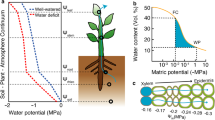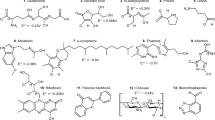Abstract
Rosmarinus officinalis L. plants were grown under carbon dioxide concentrations of 350 and 700 μmol/mol (atmospheric CO2 and elevated CO2) and under two levels of irrigation (high water and low water) from October 1, 1994 to May 31, 1996. Elevated CO2 led to increasingly larger monthly growth rates than the atmospheric CO2 treatments. The increase was 9.5% in spring 1995, 23% in summer 1995, and 53% in spring 1996 in the high-water treatments, whereas in low-water treatments the growth response to elevated CO2 was constrained until the second year spring, when there was a 47% increase. The terpene concentration was slightly larger in the elevated CO2 treatments than in atmospheric CO2 treatments and reached a maximum 37% difference in spring 1996. There was no significant effect of water treatment, likely as a result of a mild low water treatment for a Mediterranean plant. Terpene concentration increased throughout the period of study, indicating possible age effects. The most abundant terpenes were α-pinene, cineole, camphor, borneol, and verbenone, which represented about 75% of the total. No significant differences were found in the terpene composition of the plants in the different treatments or seasons. The emission of volatile terpenes was much larger in spring (about 75 μg/dry wt/hr) than in autumn (about 10 μg/dry wt/hr), partly because of higher temperature and partly because of seasonal effect, but no significant difference was found because of CO2 or water treatment. The main terpene emitted was α-pinene, which represented about 50% of the total. There was no clear correlation between content and emission, either quantitatively or qualitatively. More volatile terpenes were proportionally more important in the total emission than in total content and in autumn than in spring.
Similar content being viewed by others
REFERENCES
BRUIN, J., SABELIS, M. W., and DICKE, M. 1995. Do plants tap SOS signals from their infested neighbours? Trends Ecol. Evol. 10:167–170.
BRYANT, J. P., CHAPIN, F. S., III, and KLEIN, D. R. 1983. Carbon/nutrient balance of boreal plants in relation to vertebrate herbivory. Oikos 40:357–368.
CROTEAU, R. 1977. Effect of irrigation method on essential oil yield and rate of oil evaporation in mint grown under controlled conditions. Hort. Sci. 12:563–565.
ENDERS, G. 1994. Biogenic emissions in the Mediterranean area. BEMA-Project. Joint Research Centre, European Comission. ECSC-EC-EAEC Brussels-Luxembourg, 1994.
GERSHENZON, J. 1994. Metabolic cost of terpenoid accumulation in higher plants. J. Chem. Ecol. 20:1281–1328.
GERSHENZON, J., and CROTEAU, R. 1991. Terpenoids, pp. 165–219, in G. A. Rosenthal and M. R. Berenbaum (eds.). Herbivores, Their Interactions with Secondary Metabolites, Vol. 1. The Chemical Participants. Academic Press, New York.
HALL, G. D., and LANGENHEIM, J. H. 1986. Temporal changes in the leaf monoterpenes of Sequoia sempervirens. Biochem. Syst. Ecol. 14:61–69.
HARBORNE, J. B. 1991. Recent advances in the ecological chemistry of plant terpenoids, pp. 399–426, in J. B. Harborne and F. A. Tomes-Barberan (eds.). Ecological Chemistry and Biochemistry of Plant Terpenoids. Clarendon Press, Oxford.
HERMS, D. A., and MATTSON, W. J. 1992. The dilemma of plants: To grow or to defend. Q. Rev. Biol. 67:283–335.
JOHNSON, R. H., and LINCOLN, D. E. 1990. The role of carbon-based plant secondary metabolites in decomposition in terrestrial ecosystems. Oecologia 84:103–110.
KIMBALL, B. A. 1983. Effects of increasing atmospheric CO2 on vegetation. Agron. J. 75:779–789.
KOTZIAS, D., SPARTA, C., and DUANE, C. 1992. Distribution of optical isomers of monoterpenes (+)-α-pinene in the leaf oil of conifers. Naturwissenschaften 92:24–26.
LAMB, B., WESTBERG, H., and ALLOW WATERINE, G. 1985. Biogenic hydrocarbon emissions from deciduous and coniferous trees in the United States. J. Geophys. Res. 90:2380–2390.
LAMBERS, H. 1993. Rising CO2, secondary plant metabolism, plant-herbivore interactions and litter decomposition. Theoretical considerations. Vegetatio 104/105:263–271.
LANGENHEIM, J. H. 1994. Higher plant terpenoids: A phytocentric overview of their ecological roles. J. Chem. Ecol. 20:1223–1280.
LAVOLA, A., and JULKUNEN-TIITTO, R. 1994. The effect of elevated carbon dioxide and fertilization on primary and secondary metabolites in birch, Betula pendula (Roth), Oecologia 99:315–321.
LERDAU, M., and PEÑUELAS, J. 1993. Los terpenos en la atmósfera: vínculos entre la biosfera y la atmósfera. Mundo Cient. 131:60–63.
LERDAU, M., MATSON, P., FALL, R., and MONSON, R. 1995. Ecological controls over monoterpene emissions from Douglas-fir (Pseudotsuga menziesi). Ecology 76(8):2640–2647.
LINCOLN, D. E. 1993. The influence of plant carbon dioxide and nutrient supply on susceptibility to insect herbivores. Vegetatio 104/105:273–280.
LINCOLN, D. E., and COUVET, D. 1989. The effect of carbon supply on allocation to allelochemicals and caterpillar consumption of peppermint. Oecologia 78:112–114.
LOVETT, J. V., RYUNTYU, M. Y., and LIU, D. L. 1989. Allelopathy, chemical communication and plant defense. J. Chem. Ecol. 15:1193–1202.
PEÑUELAS, J., and MATAMALA, R. 1990. Changes in N and S leaf content, stomatal density and specific leaf area of 14 plant species during the last three centuries of CO2 increase. J. Exp. Bot. 230:1119–1124.
PEÑUELAS, J., LLUSIA, J., and ESTIARTE, M. 1995a. Terpenoids: A plant language. Trend. Ecol. Evol. 10(7):289.
PEÑUELAS, J., BIEL, C., and ESTIARTE, M. 1995b. Growth, biomass allocation, and phenology responses of pepper to elevated CO2 concentrations and different water and nitrogen supply. Photosynthetica 31(1):91–99.
PEÑUELAS, J., RIBAS-CARBO, M., and GILES, L. 1996a. Allelochemical effects on plant respiration and on oxygen discrimination by alternative oxidase. J. Chem. Ecol. 22(4):801–806.
PEÑUELAS, J., ESTIARTE, M., KIMBALL, B. A., IDSO, S. B., PINTER, P. J., JR., WALL, G. W., GARCIA, R. L., HANSAKER, D. J., LAMORTE, R. L., and HENDRIX, D. L. 1996b. Variety of responses of plant phenolic concentrations to CO2 enrichment. J. Exp. Bot. 47(302): 1463–1467.
PEÑUELAS, J., ESTIARTE, M., and LLUSIA, J. 1997. Carbon-based secondary compounds in plants grown under elevated CO2. Photosynthetica 33: In press.
POORTER, H. 1993. Interspecific variation in the growth response of plants to an elevated ambient CO2 concentration. Vegetatio (104)105:77–97.
ROSS, J. D., and SOMBRERO, C. 1991. Environmental control of essential oil production in Mediterranean plants, pp. 64–94, in J. B. Harborne and F. A. Tomes-Barberan (eds.). Ecological Chemistry and Biochemistry of Plant Terpenoids. Clarendon Press, Oxford.
ROTH, S. K., and LINDROTH, R. L. 1994. Effects of CO2-mediated changes in paper birch and white pine chemistry on gypsy moth performance. Oecologia 98:133–138.
SCHINDLER, T., and KOTZIAS, D. 1989. Comparison of monoterpene volatilization and leaf-oil composition of conifers. Naturwissenschaften 76:475–476.
SEUFERT, G., KOTZIAS, D., SPARTÀ, C., and VERSINO, B. 1995. Volatile organics in Mediterranean shrubs and their potential role in a changing environment, in W. C. Oechel and J. M. Moreno (eds.). Anticipated Effects of a Changing Global Environment on Mediterranean Type Ecosystems. Ecological Monographs. Springer-Verlag, Berlin.
SINGH, H. B., and ZIMMERMAN, P. B. 1992. Atmospheric distribution and sources of nonmethane hydrocarbons, pp. 177–235, in J. O. Nriagu (ed.). Gaseous Pollutants: Characterization and Cycling. John Wiley, New York.
TINGEY, D. T., TURNEY, D. P., and WEBER, J. A. 1991. Factors controlling the emissions of monoterpenes and other volatile organic compounds, pp. 93–119, in T. D. Sharkey, E. A. Holland, and H. A. Mooney (eds.). Trace Gas Emission by Plants. Academic Press, San Diego.
TYSON, B. J., DEMENT, W. A., and MOONEY, H. A. 1974. Volatilisation of terpenes from Salvia mellifera. Nature 252:119–120.
YOKOUCHI, Y., and AMBE, Y. 1984. Factors affecting the emission of monoterpenes from red pine (Pinus densiflora). Plant Physiol. 75:1009–1012.
ZOU, J., and CATES, R. G. 1995. Foliage constituents of Douglas fir (Pseudotsuga menziesii (Mirb.) Franco): Their seasonal variation and potential role in Douglas fir resistance and silviculture management. J. Chem. Ecol. 21(4):387–402.
Author information
Authors and Affiliations
Rights and permissions
About this article
Cite this article
Peñuelas, J., Llusià, J. Effects of Carbon Dioxide, Water Supply, and Seasonality on Terpene Content and Emission by Rosmarinus officinalis . J Chem Ecol 23, 979–993 (1997). https://doi.org/10.1023/B:JOEC.0000006383.29650.d7
Issue Date:
DOI: https://doi.org/10.1023/B:JOEC.0000006383.29650.d7




